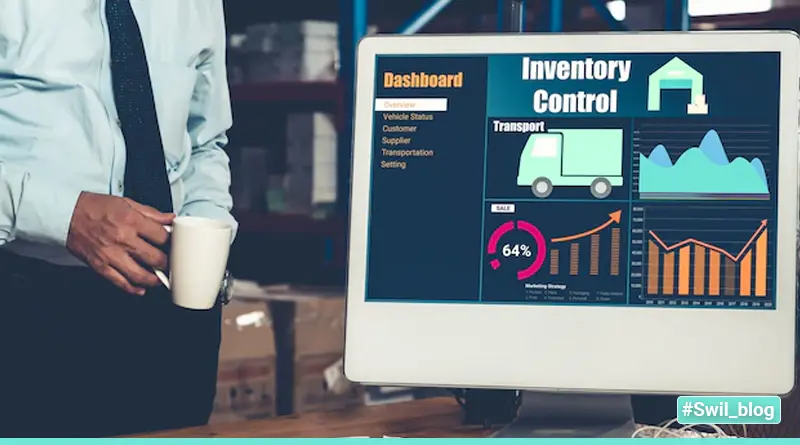Inventory is the lifeline of any retailer. Without the product, there is no business. The items you create tell a story, build your brand, and generate income and profits.
Like most businesses, inventory management has a fun side. However, there is also an unattractive but operationally important side to it. Nothing beats the excitement of deciding what to sell, finding the right vendor, researching samples, and placing your first inventory order.
However, how you manage your inventory after it arrives and when it’s sold out can tell a lot about the fate of your retail business. Just-in-time (JIT) inventory management is a proven retail inventory management method. It helps you manage your store operations more efficiently and profitably.
If JIT is an unfamiliar concept for you, you are in the correct place. In this complete guide to just-in-time inventory, SWIL will help you understand the concept of JIT in depth.
Article Content-
- Just–in–Time Inventory Management : Meaning
- Some real-time examples of Just–in–Time inventory
- How does Just–in–Time inventory work for a business?
- What does a Just–in–Time inventory management require?
- Some key benefits of Just–in–Time inventory management
- How is Just–in–Time different from other retail inventory management methods?
- Different types of businesses that benefit from Just–in–time system
- How does Just–in-Time management improve your business?
- Inventory management software and why you should invest in one TODAY!
- How SWIL’s software helps your business to up your Just–in–Time strategy and maximize your sales
- Concluding Thoughts
Just–in–Time Inventory Management : Meaning
Just-in-time inventory (JIT) is an inventory management strategy that companies employ to increase efficiency and minimize waste during the production process. Retail and wholesale companies using the JIT inventory management technique manage their supply chains efficiently. They process inventory according to forecasts or current demand for their products.
Companies using the Just–in–time inventory control system have limited inventory of products. They replenish in real time when there is additional customer demand. Instead of bulking up to create additional inventory at the beginning of the sales period. Small retailers can also use the Just–in–time inventory method to organize the delivery process of their products.
Just–in-Time inventory system is a method of inventory management in which a business produces less inventory to cut costs and increase profitability. Due to intensifying competition and increasing pressure to increase profitability, many companies are adopting this strategy to increase their profitability. This can be a problem when the supply chain goes down. Keep reading further to learn more about just in time inventory.
Some real-time examples of Just–in–Time inventory

An example of just–in–time inventory is, a company that sells but does not manufacture office ergonomic chairs will only order the chairs from the manufacturer if the customer places an order and purchases it.
Another example of just–in–time inventory management is large clothing retailers or small e-commerce companies use JIT management by producing a certain number of clothing or accessories based on demand forecast. When popular items are out of stock, these companies may produce additional items for those on the waiting list. Many large retail chains also use JIT inventory to order holiday and seasonal items.
Just–in–time inventory management method is also popular in the Bookstore industry. They use a book publishing system that prints only a specified number of books according to the fulfillment of an order. This reduces waste of paper and the number of unsold books.
How does Just–in–Time inventory work for a business?

With JIT management, retailers only order inventory when needed. This system uses Kanban, an inventory management system that tracks materials when they are out of stock. When the product runs out, new consumables will be ordered. Raw materials are delivered only in sufficient inventory to meet production needs (according to demand forecast) or customer demand when production is about to begin.
The JIT manufacturing process does not stock up extra inventory, so a trusted supplier needs to work effectively. However, JIT inventory can streamline a company’s production cycle, increase sales, reduce inventory costs, and save money by running smoothly.
Just-in-time requires careful planning of the entire supply chain, good software to manage the entire process, and monitoring each operation to increase efficiency and reduce the likelihood of error. The goal is to keep inventory low, increase efficiency, eliminate waste, and maintain mass production. Many companies implement just-in-time stock management to reduce costs and stay competitive.
What does a Just–in–Time inventory management require?

Companies using just-in-time delivery systems must be able to accurately predict demand. JIT delivery is also an important part of lean manufacturing. Lean manufacturing is a method that aims to maximize productivity and minimize waste. Since the two are interconnected, you need to implement just-in-time delivery to fit the overall lean manufacturing scheme. The following items are required for a successful JIT implementation:
- Standardized operation
- Quality improvement
- Pull production
- One-piece flow
- Reliable equipment / machine
- Well-designed work cell
Some key benefits of Just–in–Time inventory management

JIT inventory management has numerous proven benefits. It helps to elevate a business’s ROI by lowering warehouse costs, improving efficiency and reducing production waste. Let’s look at other benefits:
Minimized waste
The JIT inventory system reduces dead stock by minimizing overstocking. It rather focuses on on-demand orders. Similarly, this inventory management method saves on raw material and warehouse space costs for storage. This is opposite to when goods are mass-produced far beyond customer demand.
Improved productivity
JIT improves productivity by reducing the time and resources required during the manufacturing process. Manufacturers can manufacture products faster. JIT allows manufacturers to deliver new products faster and easier. Fewer raw material inventory adjustment is required before product changes. It is easier to implement engineering changes in orders in existing products.
Trouble-free production process
Just–in–time inventory systems can cut out several flaws throughout the production process. JIT reduces the manufacturing time and shortens customer lead time. There are fewer defective products as you can identify and fix production defects faster. Shorter equipment setup time is required. It shortens the production process and reduces investment in finished products. This inventory system also eliminates work-in-process queues in workstations.
Cost reduction
The low inventory levels associated with Just–in-Time reduces the amount of working capital required. It helps to minimize inventory costs because less warehouse space is required. JIT does not require large inventory levels. Hence, companies invest less cash in their inventory. With JIT, companies can order raw materials on demand. This makes cash available for other uses that are more valuable. Labor costs are lower because the man-hours required to process an order are reduced.
Quality improvement
The business can focus on producing high quality products with few defects. Better results increase customer satisfaction. Fewer items move through which allows the workshop to focus on creating products with superior quality. Minimal inventory levels reduce storage-related accidents. The shipments can be sent directly to the production area rather than waiting for quality inspection on goods receipt.
Improved work environment
The Just–in-Time inventory system allows enterprises or SMEs to spend more resources and effort on final product quality and customer satisfaction. They stop worrying about storage space prices and security or raising inventory levels. This leads to stress – free work environment and improves the work environment of employees. This in turn leads to productive and happy employees.
How is Just–in–Time different from other retail inventory management methods?

Just-in-time is just one among other inventory management techniques. However, the significant difference between JIT and other inventory management techniques is that JIT is a “pull” system. Other inventory management systems are usually “push” systems.
Pull inventory management system arises from customer demand. This means that the inventory is ordered to meet the actual customer needs. In some cases, this means waiting for the customer to make a purchase before producing the stock in bulk.
A traditional inventory approach assumes a functional organization designed to minimize the manufacturing costs of each component. The JIT system organizes intermediate processes to directly meet the requirements from later production stages.
Different types of businesses that benefit from Just–in–time system

Just–in–time inventory management techniques are used in various industries to streamline production and increase profits. Some of the most beneficial businesses that use JIT systems include:
Retail stores
Large retailers or small companies use JIT management by producing a certain number of clothing or accessories based on expectations. When popular items are out of stock, these companies may produce additional items for those on the waiting list. Many large retail chains also use JIT inventory to order holiday and seasonal items.
One of the highest costs for retailers is the inventory cost associated with accommodating overstock. Rent, electricity, water and other high inventory overhead can quickly run out of these margins before they run out and reach the customer’s hands.
Inventory obsolescence or “dead stock” is a major problem faced by retailers in retail industries such as technology and fashion. With the JIT system, you don’t have to worry about products that no one wants. You don’t have to lower prices to clear inventory. You can enjoy your profit margin. Buying a large amount of inventory means that you are binding the funds in your inventory that you have to wait for depreciation.
The JIT inventory management means that you don’t stockpile large amounts of cash that you don’t know if you will need it later. Instead, these resources are used in areas that can give your business more benefits.
Book stores
Just–in–time inventory system is beneficial for the book business where on-demand publishing is used. This is a book publishing system that prints only a specified number of books. This is done only to process an order that has been placed. It reduces paper and the number of unsold books. This also reduces the chances of theft. Inventory can be tracked better due to the minimal quantity. It reduces the opportunity for bulking on books, leading to inefficient inventory management.
Food stores
Many independent restaurants and hotels use Just-in-Time inventory management rather than ordering large quantities of food stock. Also, lead it to rot in the freezer for days or weeks. This reduces food storage costs and waste. Quick service restaurant chains, such as fast food service companies, also use the JIT technique. They cook and pack meals when they receive an order, rather than preparing and reheating food in advance.
Automobile stores
The Just-in-Time inventory system was developed by the car manufacturer Toyota in Japan. It is sometimes called the Toyota Production System “TPS”. Many automakers continue to use the JIT inventory management system to manage their supply chains and manufacturers. This is done to avoid the high costs of mass-producing unsold car inventories.
Technology
Businesses in the technology sector, such as computer and other electronic gadget manufacturers, run on the lean operation. They order parts only when customers place an order for a product. Rather than stocking a warehouse full of pre-assembled computers and gadgets. Through just–in–time inventory, tech companies cut costs, and lead time is also reduced.
How does Just–in-Time management improve your business?
Just-in-time inventory management reduces your manufacturing waste, maximizes cash flow, and promotes flexibility. It also facilitates talent and teamwork. JIT is successful inventory management that maximizes profits and it minimizes inventory investment. It helps companies reap the benefits of their hard work by not wasting their money on unnecessary costs. It also helps your employees focus on important tasks rather than quality assurance. It ends up improving your business environment and productivity.
Inventory management software’s and why you should invest in one TODAY!

Companies that are top-scoring in their Just–in–Time inventory game have invested in efficient inventory management software. They use this software to collect and analyze data related to shipments, customer feedback, loss prevention, warehousing, purchases, backlogs, inventories, receipts, inventory turnover, accounting and much more.
This type of software tracks sales data and allows you to more accurately predict your inventory needs. You can also easily track your current inventory quantity.
Inventory management software allows you to set a reorder point for each item in the catalog. When you reach them, your system will notify you when you need to backorder the goods. Some software can also place these orders automatically.
Once you realize that JIT has the potential to help your business, don’t waste any more time. Start today by investing your money in an efficient inventory management software.
How SWIL’s software helps your business to up your Just–in–Time strategy and maximize your sales

SWIL can streamline all aspects of your inventory management and simplify the implementation of just-in-time systems. The software is an all-in-one software solution for retail and distribution businesses. It allows you to track sales and manage inventory. It also makes the process of generating and sending invoices quick and simple.
It keeps you well updated about business development graphs. It automates all business processes and presents you with an efficient manner of carrying our operations. SWIL software is integrated with a robust point-of-sale system used to process customer transactions. You can receive payments, and update retail store inventory levels in no time.
The software also has the ability to display real-time pricing scenarios and inventory tracking. It notifies you about out-of-stock products to avoid lost sales scenarios. You can track your sales and supplier performance with the help of analytical reports. Get notified about product expiration dates, returns and much more.
Concluding Thoughts
A just-in-time strategy avoids the waste associated with ordering and storing additional inventory. To adopt JIT, you need to review the entire business of the company. Right from raw materials to finished products needs to be analyzed. This strategy reduces overall financial investment and storage costs. It also minimizes the infrastructure required for warehouse management. If opted for your business after a thorough assessment, it can work wonders for you.





